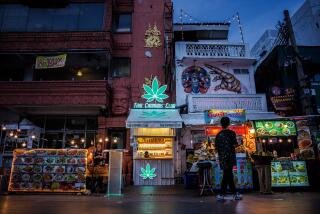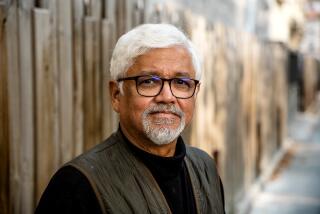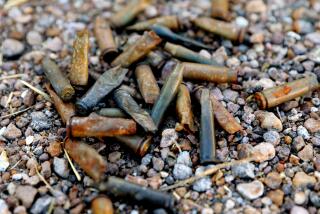India Emerging as a Major Hub of Heroin Trade
NEW DELHI â Sri Dham is a handsome, young air-conditioning merchant, the father of two small children and the devoted son of aged parents. He was also a heroin addict.
He told an interviewer that he used up to five grams a day before he quit recently after treatment in a rural hospital.
âI killed my urge,â he said proudly.
Then, drug-free, he returned to the source of his addiction, the incense-scented web of narrow lanes and alleys in Delhiâs Paharganj bazaar. His mission: to persuade other addicts to quit before it is too late.
âSpreading Like Choleraâ
âThis plague is spreading like cholera,â he said. âIf our country wants a chance for a future, we must put a stop to it.â
Dhamâs gloomy message, delivered in a sari shop near the old mosque on the bazaarâs main road, fell mostly on deaf ears. Two men in the shop slept soundly. The bleary-eyed shopkeeper, Lal Kumar, who said he smokes a gram of heroin a day, listened for a time and then wandered unsteadily into the chaos of the bazaar, leaving the sleeping men to mind the shop.
âProbably left to have another smoke,â Dham said with evident disgust.
The scene in Paharganj, a place favored by young European tourists because of its many cheap hotels, reflects the growing problem of heroin addiction in India.
From 30,000 to 100,000
Until a few years ago, addiction was confined mostly to the 30,000 opium users who register with the government and are issued rations of their drug. Now, drug officials here say, there are more than 100,000 heroin addicts in India, most of them in Bombay and New Delhi.
According to Indian and American narcotics specialists, the use of heroin is a side effect of a larger problem: the recent emergence of India as an important international distribution center for heroin.
A. M. Sethi, secretary of the Indian Revenue Bureau of Intelligence, and John H. King, an officer of the U.S. Drug Enforcement Administration, talked about the problem in separate interviews.
They said that only five years ago, India had a small part in the world heroin traffic. The two main opium-growing regions, the so-called Golden Triangle formed by Burma, Thailand and Laos to the east and the so-called Golden Crescent of Afghanistan and Pakistan to the west, used more direct routes to get their product to the lucrative markets of North America and Europe.
Producers Left Scrambling
But stricter enforcement in the east, in Burma and Thailand, and political upheaval in the west, including the Soviet invasion of Afghanistan and the Iranian revolution, left heroin producers scrambling. And India, sandwiched between the two main growing regions, became the obvious conduit. Indiaâs already established smuggling operations in other products were converted to the task.
âIndia was the right place at the right time,â said King, who has been here for six years. âA lot of the people who are now involved in heroin were heretofore involved in gold, silver and electronics smuggling.â
The main heroin-smuggling activity is in the west, along the rugged 1,400-mile border between Pakistan and India, in the Rajasthan Desert,
Hard to Patrol
That area is âextremely difficult terrain to patrol,â King said. âJeeps canât survive there. The heroin is walked across the border on camels, on horses and on the backs of men, any way they can get it here.â
King estimates that between three and five tons of heroin crossed the frontier last year from Pakistan into India. Estimated heroin consumption in the United States is seven tons a year, about half of which is believed to come from Southwest Asia, primarily Pakistan and Afghanistan.
In the last six months, Indian narcotics agents working under Sethi at the Indian Revenue Bureau of Intelligence have intercepted more than a ton of heroin on its way to Bombay from Pakistan.
1,350 Pounds Seized
The bulk of this was involved in what is thought to be the biggest single seizure in history--615 kilos, roughly 1,350 pounds. Prepared for sale on the street in the United States, it would bring several million dollars. It was hidden in haystacks on a farm in a tribal area near Talasari, 90 miles north of Bombay. A drug agent investigated because the farm had many more haystacks than adjacent farms.
Late last year, two other large caches of heroin were confiscated in India, one of about 200 kilos and the other of about 300--in all, roughly 1,100 pounds. Such large seizures are extremely rare. Together, the three Indian seizures exceed all the heroin confiscated in the United States by the Drug Enforcement Administration in the fiscal years 1983 through 1985.
The large seizures in India suggest that the traffic in narcotics is even larger than the experts had thought. Drug enforcement officials elsewhere in the world estimate that they intercept no more than 10% of the volume being moved, but to apply this rule of thumb to Indiaâs experience would produce numbers far beyond even the most extreme previous estimates.
âNumber . . . Too Scaryâ
âThe number would be too scary,â King said. âThey are almost seizing more heroin here than is being used under our old estimates.â
But King does not believe that the large seizures mean that most of the heroin being moved is being intercepted.
âThese guys are good businessmen,â he said. âThey would not trust this vast amount to a smuggling route that was not very successful.â
In response to the increased drug traffic, the Drug Enforcement Administration is expanding its full-time staff in India and opening another office, in Bombay. And Atty. Gen. Edwin Meese III conferred here in March with Prime Minister Rajiv Gandhi and other Indian officials. Afterward, Meese announced that a âworking groupâ of U.S. and Indian officials will be set up to consider ways to cooperate.
Traffic From Burma
Law enforcement officials also are alarmed by what appears to be a new trend in the narcotics traffic. Significant amounts of heroin are coming into India from opium-processing areas in northeastern Burma. According to King, this new traffic began three years ago after Thailand and Burma made it a criminal offense to possess acetic anhydride, a common industrial chemical used in producing heroin from opium.
âIn order to produce heroin, you need this one chemical,â King said. âBut possession of acetic anhydride in Burma and Thailand carries the same penalty as heroin itself. So, they began to get it from India, where it was easily available.â
Once the routes were established to move the chemical--from the Indian states of Mizoram and Manipur through Mandalay into the insurgent areas of northeast Burma where the heroin is produced--the producers discovered they could just as easily send heroin back along the same path, King said.
Government Takes Action
So, in addition to the significant increase in heroin from Pakistan and Afghanistan in the west, there has also been an increase in volume from Burma.
To combat this trend, the Indian government recently included acetic anhydride in its Essential Commodities Act, requiring people who deal in the chemical to register with the central government.
Additionally, the Indian Parliament approved in November the Narcotic Drugs and Psychotropic Substances Act, which is similar to legislation on controlled substances in the United States. The act increased the penalties for drug offenses and created a Central Narcotics Control Board.
Previously, controlling narcotics had been the responsibility of the Bureau of Revenue in the Ministry of Finance, which was established by the British more than a century ago to regulate production on Indiaâs large opium farms.
Largest Legal Opium Producer
India long has been the worldâs largest producer of legal opium. More than 65,000 acres in three Indian states are planted in opium poppies, and more than 700 tons of opium are produced every year, much more than in Turkey and Australia, Indiaâs rivals in the field. More than 80% of the opium used in prescription drugs in the United States comes from India.
Inspectors who live near the poppy fields carefully monitor the opium operation, so that very little of the drug enters the illegal market. The inspectors even go into the fields after wind and hailstorms to evaluate damage.
âSo far, the diversion from legal opium fields has not been a major problem, nothing to be alarmed about,â King said.
But Indian officials are concerned that the increased traffic in heroin will make it more difficult to keep the legal opium from spilling into the market.
Payments to Farmers
The government pays Indian farmers 300 rupees (about $25) for each kilogram they produce, but they could get much more than that on the open market. (A kilogram is equal to roughly 2.2 pounds.)
âMind you, these are very poor men,â an Indian narcotics specialist said. âAt their doorstep, they could get 1,000 rupees for the same opium for which we pay them 300 rupees.â
âThis is not a problem now,â a senior Indian official said, âbut it could easily become a problem. I donât want our fields to become an Indian crescent.â
The Indian officials say they need new vehicles and aircraft, particularly helicopters, to monitor activity at their opium fields. They are concerned that Pakistan, where there are many illegal fields, gets the bulk of international funds in South Asia for narcotics control.
âWill Not Beg for Aidâ
âMy government will not beg for aid,â one Indian official said. âWe will not go with a begging bowl to the U.S. But we do need their help. Ultimately, it is as much their problem as it is ours.â
Indian officials have only recently begun to face up to the problem of heroin addiction in India. India has not had such a serious addiction problem since opium-eating contributed to the downfall of the Mogul empire nearly 400 years ago.
Until a few years ago, heroin was a rare sight in Delhi and Bombay. Sri Dham, an addict for more than six years, said he was among the first to take up the drug.
âI told people it was medicine from Germany,â he said. âNo one knew what it was. Now it is everywhere, from the lowest pauper to the richest family.â
50% Pure Heroin
Indeed, it is no longer uncommon to see men and women using heroin, even in outlying communities. The heroin here is about 50% pure (compared to about 3% to 5% for most street heroin in the United States), and it looks like brown sugar. It is usually smoked rather than injected.
What makes it such a problem is that it is so cheap and therefore accessible to most income groups. In India, heroin costs about $3 a gram, compared to more than $1,200 a gram in the United States, King said.
âThe heroin in the streets here is the cheapest in the world,â an Indian official said. âIt is becoming a greater problem for us because our students, our children, are getting on it because they can buy it with pocket money.
More to Read
Sign up for Essential California
The most important California stories and recommendations in your inbox every morning.
You may occasionally receive promotional content from the Los Angeles Times.










